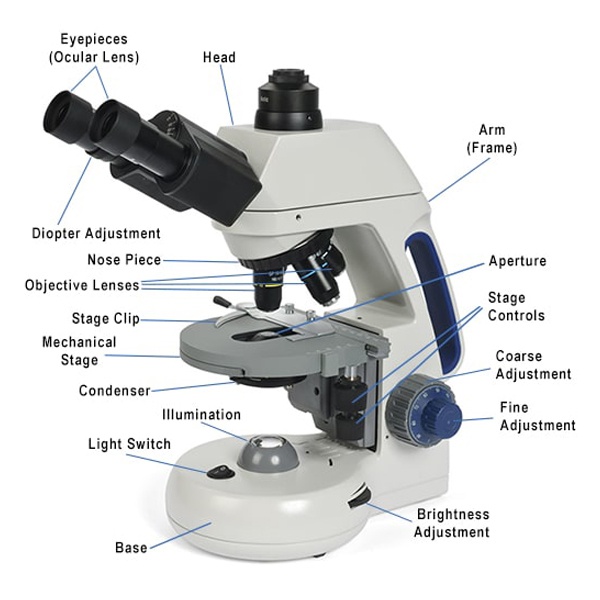Posted by Fred Koenig on Nov 18th 2020
Compound Microscope Parts, Functions, and Labeled Diagram
Parts of a Compound Microscope
Each part of the compound microscope serves its own unique function, with each being important to the function of the scope as a whole. The individual parts of a compound microscope can vary heavily depending on the configuration & applications that the scope is being used for. Common compound microscope parts include:

Compound Microscope Definitions for Labels
- Eyepiece (ocular lens) with or without Pointer: The part that is looked through at the top of the compound microscope. Eyepieces typically have a magnification between 5x & 30x.
- Monocular or Binocular Head: Structural support that holds & connects the eyepieces to the objective lenses.
- Arm: Supports the microscope head and attaches it to the base.
- Nosepiece: Holds the objective lenses & attaches them to the microscope head. This part rotates to change which objective lens is active.
- Base: Bottom base of the microscope that houses the illumination & supports the compound microscope.
- Objective lenses: There are usually 3-5 optical lens objectives on a compound microscope each with different magnification levels. 4x, 10x, 40x, and 100x are the most common magnifying powers used for the objectives. The total magnification of a compound microscope is calculated by multiplying the objective lens magnification by the eyepiece magnification level. So, a compound microscope with a 10x eyepiece magnification looking through the 40x objective lens has a total magnification of 400x (10 x 40).
- Specimen or slide: The object used to hold the specimen in place along with slide covers for viewing. Most slides & slide covers are thin glass rectangles.
- Stage or Platform: The platform upon which the specimen or slide are placed. The height of the mechanical stage is adjustable on most compound microscopes.
- Stage clips or mechanical stage: Clips on the stage that hold the slide in place on the mechanical stage.
- Aperture - Disc or Iris Diaphragm: Circular opening in the stage where the illumination from the base of the compound microscope reaches the platform of the stage.
- Abbe Condenser: This lens condenses the light from the base illumination and focuses it onto the stage. This piece of the compound microscope sits below the stage & typically acts as a structural support that connects the stage to arm or frame of the microscope.
- Coarse and fine adjustment controls: Adjusts the focus of the microscope. These knobs increase or decrease the level of detail seen when looking at the slide or specimen through the eyepiece of the compound microscope.
- Stage height adjustment: Adjusts the position of the mechanical stage vertically & horizontally. It is important to adjust these knobs so that the objective lens is never coming into contact with the slide or specimen on the stage.
- Mirror: Reflects light into the base of the microscope. Earlier microscopes used mirrors that reflected light into the base of the microscope instead of halogen bulbs as their source of illumination.
- Illumination: Light used to illuminate the slide or specimen from the base of the microscope. Low voltage halogen bulbs are the most commonly used source of illumination for compound microscopes.
- Bottom Lens or Field Diaphragm: Knob used to adjust the amount of light that reaches the specimen or slide from the base illumination.
Learn More About Microscopes
If you'd like to learn more about microscopes, checkout our useful articles below:
- What is a compound microscope?
- What is a stereo microscope?
- What is a digital microscope?
- What is a fluorescence microscope?
